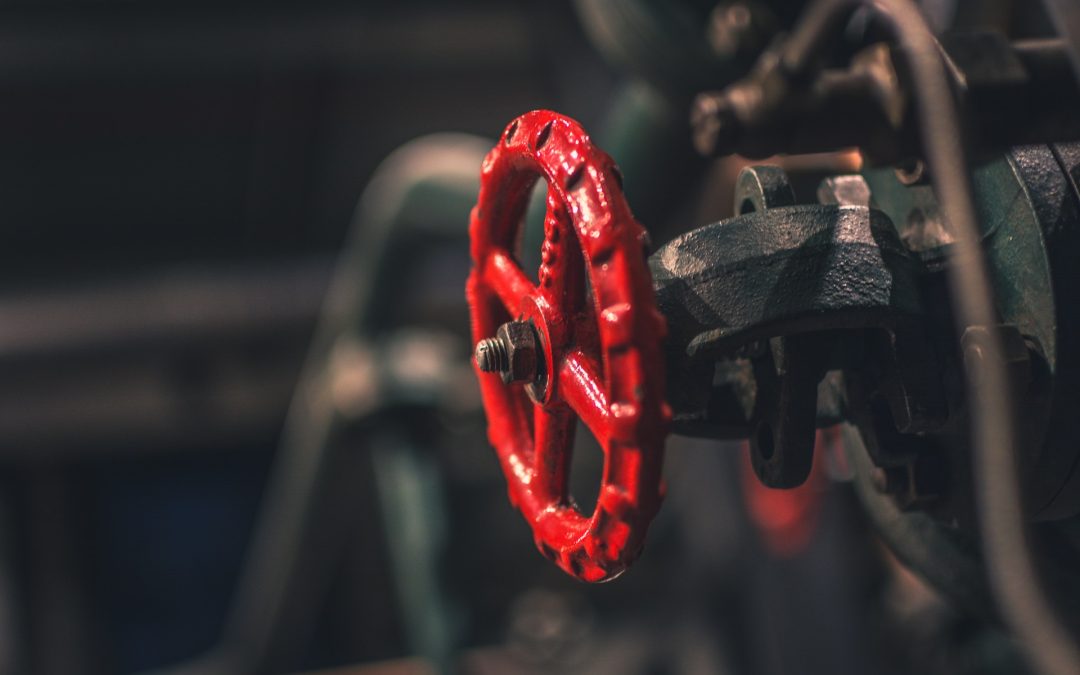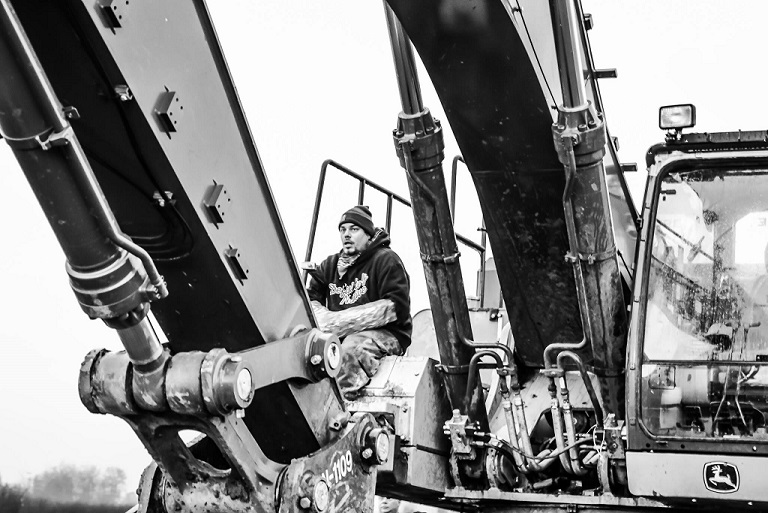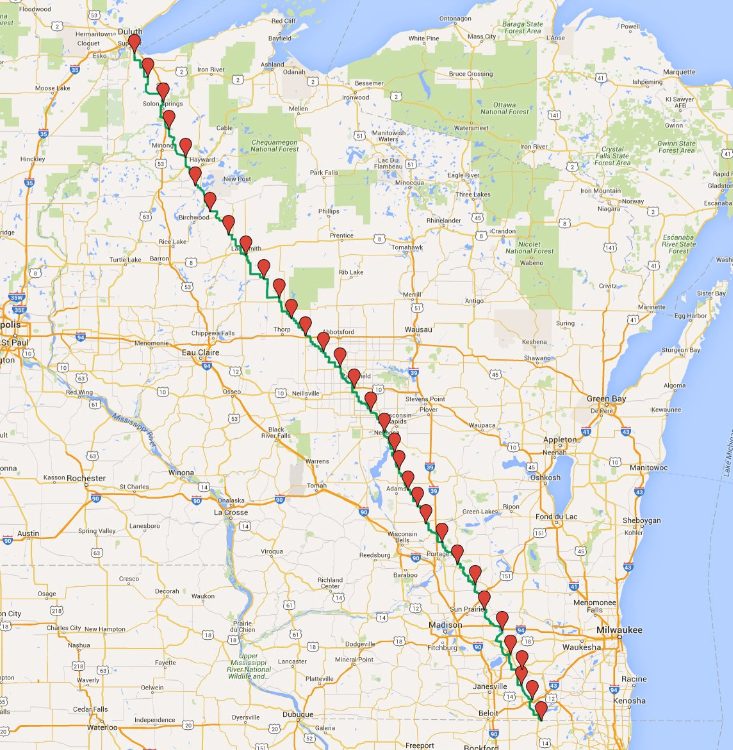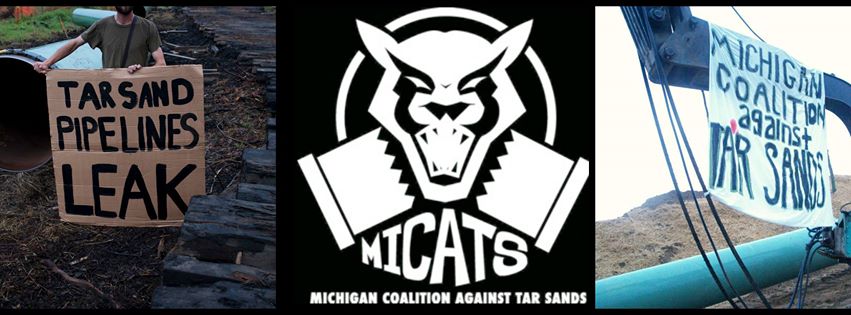
by DGR News Service | Aug 4, 2023 | NEWS, Property & Material Destruction
Editor’s Note: Protests and demands by the mainstream environmental movement has yet failed to make any substantial changes in the ecological health of the natural world. Day by day, the situation is getting worse. Ecosabotage, on the other hand, deals directly with the problem and stops the powerful’s ability to control nature. The following is a communique submitted anonymously to, and originally published by, Unsalted Counter Info.
Reportback from some valve turners
It is with a heavy heart and hazy skies we announce that 2 different pipeline valves were turned off along the Line 5 route on Anishinaabae land in the great lakes region.This was done on the 13th anniversary of the Kalamazoo River oil spill.This was the 2nd largest inland oil spill in amerikkkan history, dumping 1,000,000 gallons of tar sands crude oil into the river and causing untold damage to the water, land and those who live on it.
Currently, Enbridge is preparing to construct a concrete tunnel beneath the waters of the so-called Great Lakes to house a dual pipeline system in order to increase flow rates and carry even more tar sands from the lands of the north to refineries in the south. The Straits tunnel project is meant to replace a 70 year old pipe that is hastily secured to the bottom of the lake bed, even free floating in some areas.
Enbridge claims that the tunnel is safe, but a tunnel project beneath the straits is a resource intensive project. The tar sands would continue to be extracted, desecrating the land in northern geographies. The refineries in the south still pumping out toxic fumes that pollute nearby Black neighborhoods. The camps of workers near both the straits and the Bad River reroute still disappearing Indigenous women and relatives.The companies that rely on Enbridge oil still operating in the towns and cities, underpaying workers and enacting anti-Black and anti-Indigenous violence in nearby communities.The tunnel itself, bored through the bedrock beneath the water, containing two high-volume pipelines transporting millions of barrels of oil monthly, operated by a company with a long history of environmental catastrophe.
It’s easy to turn a valve. Every 10 or so miles along the pipeline route there is a pump station. Some of these pump stations are larger than others, some containing more of Enbridge’s infrastructure like work trucks, electrical stations, dynamic machinery, communication systems, and field offices. For us, we found pump stations that simply contained a valve and a small brick structure that contains basic comms and electrical components. Many of these places are remote, with response times that vary from 20 minutes to over an hour. Pump stations often contain a high-definition camera with a motion sensor mounted looking directly at the valve. When the motion sensor is triggered, the structure becomes heavily illuminated by flood lights and begins recording. Nothing some spray paint can’t fix! The structures are always surrounded by a fence and are positioned next to or on top of a service road. The pipeline route is easy to see from a satellite image, as it cuts a clear path through the forest. The valve itself sometimes has a nut that is fitted with a large wrench and turned clockwise until you hear a series of musical notes, indicating that the pressure in the pipe has changed. At some valves, there was actually a big red button that just said STOP, which stops flow immediately. For us, we found it incredibly important to call the emergency Enbridge number listed on the facility and tell them we were shutting off the valve. The engineer on the other side of the line sounded very panicked, and immediately shut off flow to the entirity of Line 5. We did this 5 minutes before actually turning the valve, to ensure that the shut down would happen safely, obviously oil spills aren’t something we want to happen as a result of our actions.
In order to protect the water, the land and all the relatives that live on it, companies like Enbridge must stop extractive projects like tar sands. They must stop the flow of oil, because all of our lives depend on it.
And if they don’t, we will.
Photo by Igal Ness on Unsplash
The 2023 DGR conference is scheduled for late August in northern California. This annual gathering is an opportunity for our community to share skills, reflect on our work, strengthen our connections, and plan for the future. While this conference is only open to DGR members, we do invite friends and allies on a case-by-case basis. If you’re interested in attending, please contact us, and if you’d like to donate to support the conference, click here.

by Deep Green Resistance News Service | Nov 20, 2017 | Obstruction & Occupation
by Makwa Initiative Line 3 Front Line Resistance
Early Wednesday morning water protectors from Camp Makwa stormed an Enbridge construction site, and delayed progress on the last unfinished Wisconsin segment of their proposed line 3 pipeline project. One individual from the Diné Nation descended into the muddy trench, climbed onto the pipe, and locked himself to welding equipment. A Leech Lake Tribal member then climbed atop an excavator and attached himself to a hydraulic arm. Construction was halted for approximately six hours, costing the company thousands of dollars, as the individuals put their bodies on the line to protect the water and the futures of their children.
See the video here
Later in the day two more water protectors were arrested, while standing on the side of the public road. They were both tackled to the ground by Sergeant Kirchhoff of the Superior Police Department. For one of the arrests, when asked on what grounds he was acting, officer Kirchhoff cited a warrant that he could not produce. Later investigation found that the warrant he cited was unsigned and improperly filed. Last Week Sergeant Kirchhoff received media attention for tackling a woman to the ground without warning at a similar protest. The woman’s charges were later dropped.
The Enbridge Line 3 Replacement Project is estimated to carry almost one million barrels of tar sands oil from Alberta, Canada to Superior, Wisconsin; Enbridge has received approval in Wisconsin, but has not received approval in Minnesota, which would be the largest segment of the proposed project. The non-violent direct action came after a week of evidentiary hearings in Minnesota, where Enbridge revealed that it had already paid for 100% of the pipe for the project. The same day as the action it was discovered that before her time in public office Judge Ann C O’Reilly, the individual in charge of holding public hearings on the Line 3 Project, worked for a firm that represented oil companies on multiple occasions.
One water protector stated “Enbridge doesn’t have their permits for Minnesota and they have already started chopping trees down for their easement and filling its pipe storage yards. We went to the public hearings and found them full to the brim with Enbridge employees who were paid to be there. We fought again and again just to have 3 minutes to speak. Now we watch as truck after truck come into our communities carrying pipes and out of state pipeline workers. We made our comments, but they didn’t listen. The project is already bringing violence to our land and our women and children. We know that with these man camps comes increased levels of drugs, rape, and missing and murdered indigenous women. Enbridge will not take no for an answer so we have to stop them. We want to make clear in no uncertain terms, Enbridge is not welcome in Minnesota.”
Donate to Camp Makwa-
Camp Supplies: youcaring.com/makwacampsupplies
Legal Fund: youcaring.com/makwalegal

by Deep Green Resistance News Service | May 22, 2016 | ACTION, Protests & Symbolic Acts
By Sacred Water Sacred Land
Sacred Water Sacred Land is sponsoring a tar sands awareness walk through Wisconsin along Enbridge’s proposed Twin Line #66 starting with a kick-off event in Delevan or Walworth on June 8th.
33 Days on Twin #66, a Sacred Water Sacred Land sponsored walk, begins at the entry point of the Enbridge pipeline system, just south of Walworth, WI and follows the route northwest to Superior, raising awareness about the existence of, and proposed expansion to, the Enbridge crude and dilbit pipeline corridor along the way.
33 Days on Twin#66 will consist of consecutive daily 10-15 mile segments with community engagement talks in a revival type setting at overnight encampments at many points along the way. The 420-mile pipeline route is broken into four major sections: northern, upper central, lower central and lower.
Winona La Duke, who has fought tirelessly against the Sandpiper expansion in Minnesota, and her sister Lorna, will be riding with us on horseback along several sections of the walk.
Affected communities and landowners will be engaged by representatives of SWSL – Sacred Water Sacred Land, CELDF – Community Environmental Defense Fund, and WiSE – Wisconsin Safe Energy Alliance, through an ecological forum where the impact of the expansion and a broader conversation about the adverse effects of Canadian tar sands extraction and transport will be explained. Guest speakers will also address climate change and traditional ties to the land while local residents will be encouraged to share their stories and efforts towards healing it.
Through this effort, SWSL endeavors to not only draw attention to the tremendous hazards of tar sands/Bakken oil transport but also help communities imagine and co-create a more sustainable, health conscious society with an emphasis on renewables and non-toxic food systems.
We are looking for additional sponsors to lend credence and build support for the Walk. Sponsorship is welcome in many forms. We encourage you to share the Walk with your membership and follow us on Facebook where specific details will be posted as they solidify. If you wish to participate in greater measure, please contact SWSL directly.
It is past time to unify our efforts and promulgate ecological systems literacy. We hope you will join us as we work together towards a paradigm shift of social and environmental justice for the natural world and the next seven generations.
Cosponsored by WiSE, CELDF, and SWSL

Schedule:
1 ~ June 8th – Walworth*, Kick-off!
2 ~ June 9th – Delavan*
3 ~ June 10th – Richmond
4 ~ June 11th – Whitewater*
5 ~ June 12th – Fort Atkinson*
6 ~ June 13th – Lake Mills*
7 ~ June 14th – Sun Prairie*
8 ~ June 15th – Columbus*
9 ~ June 16th – Wyocena
10 ~ June 17th -Portage*
11 ~ June 18th – Oxford*
12 ~ June 19th -Westfield
13 ~ June 2oth – Adams/Friendship*
14 ~ June 21st – Cottonville
15~ June 22nd – Lake Arrowhead
16 ~ June 23rd – Nekoosa*
17 ~ June 24th – Vesper
18 ~ June 25th – Marshfield*
19 ~ June 26th – Spencer
20 ~ June 27th – Riplinger
21 ~ June 28th – Owen/Withee*
22 ~ June 29th – Lublin
23 ~ July 30th – Gilman
24 ~ July 1st – Sheldon
25 ~ July 2nd – Ladysmith*
26 ~ July 3rd – Imalone
27 ~ July 4th – Meteor
28 ~ July 5th – Hauer-Stone Lake
29 ~ July 6th – Hayward
30 ~ July 7th – Gordon*
31 ~ July 8th – Salon Springs
32 ~ July 9th – Hillcrest
33 ~ July 10th – Superior*, Renewable Energy Independence Day!
* Denotes Revival

by Deep Green Resistance News Service | Dec 12, 2013 | Toxification
By Michigan Coalition Against Tar Sands (MI-CATS)
BATTLE CREEK, Noon, on December 13th:
After activist and Kalamazoo resident Chris Wahmhoff’s felony pretrial, Michigan Coalition Against Tar Sands (MI-CATS) will hold a press conference to raise awareness about chemical oil dispersants found in the Kalamazoo River. Earlier this year Chris protested Enbridge Energy by skateboarding into their pipeline and stopping construction. He was charged with resisting and obstructing an officer and faces 2 years in prison.
Scientists and residents are questioning how chemicals shockingly similar to those used in the BP Deepwater Horizon gulf oil spill, and Exxon Valdez tanker spill disasters, would end up in the Kalamazoo River from Marshall, Michigan to more than 40 miles downriver. In the aftermath of the 2010 Kalamazoo oil spill Enbridge was fined for each gallon of oil recovered. Chemical dispersant breaks up oil into unrecoverable particles. Both Enbridge and the EPA have denied that any dispersants were used.
However, since August, samples collected from the Kalamazoo River have been analyzed and found to contain chemical signatures similar to Corexit 9527, Corexit 9727A, and Corexit 9500. Corexit 9527, 9727A, 9500 are rare and are ingredients in a group of chemical oil dispersants marketed as Corexit. Corexit was used in the BP oil spill and has had carcinogenic, respiratory, and hemorrhaging effects on residents, clean-up workers, and wildlife. Calhoun County residents are experiencing these same toxicity
issues. Senior Policy analyst at the EPA, Hugh Kaufman has found effects of Corexit to be worse than the oil spill itself. Studies by a group of local and national scientists and doctors are confirming our suspicions- that chemicals dispersants or surfactants were used to hide the severity
of the 2010 tar sands oil spill.
Resident Michelle Barlond Smith, who conducted health surveys along the spill area, along with several residents along the river, reported that dump trucks would drive up to the river and dump truck loads of material into the water. We are questioning the safety of the river and the water due to these chemicals. We are concerned about human and animal health, and demanding a health study contrary to Michigan Department of Community Health’s and Calhoun County Health Officials and Agency for Toxic Substances and Disease Registry.
Join us. S River Rd, Battle Creek, MI 49014. 12:00 Noon, December 13th.
Question and answer session with scientists & activists to follow, at 4785
Beckley Rd, Battle Creek, MI 49015
by Deep Green Resistance News Service | Jun 21, 2012 | Toxification
By EcoWatch
To borrow a popular hockey term, Canada has scored a hat trick of the worst kind: Three major oil spills in just over one month.
The culprit this time around is Enbridge, the Calgary, Alberta-based operator of the world’s longest crude oil and liquids pipeline system, situated in Canada and the U.S. On June 19 the company confirmed that about 1,450 barrels (230,000 litres) of crude oil spilled from a pumping station onto farmland near Elk Point, Alberta, according to The Globe and Mail. Fortunately, this spill managed to occur in an area devoid of waterways.
Others haven’t been so lucky.
On June 7, Albertans living downstream from the Red Deer River suffered a scare when a pipeline owned by Plains Midstream Canada ruptured, spewing around 3,000 barrels of oil and posing a severe risk to the drinking water supply of 100,000 people, according to CBC News—Calgary. This spill began beneath Jackson Creek, a tributary of the Red Deer River, ending in Gleniffer Lake and reservoir where the majority of clean-up efforts and monitoring continue to take place.
According to Canada.com, the “province is still advising people not to draw water directly from the river or lake, and it’s telling people not to swim or fish in the lake, either.”
Topping them all is Pace Oil and Gas Ltd., which spilled an estimated 22,000 barrels of oil mixed with water near Rainbow Lake, in the northwestern corner of Alberta, according to Bloomberg.
Because of its remote location, the Pace Oil and Gas spill managed to stay relatively quiet despite being one of the largest and most calamitous oil spills in North America in recent years. The spill released more oil into the environment than the much higher profile Kalamazoo River spill almost two years ago in Michigan, compliments of—yet again—Enbridge, that pumped around 19,500 barrels into the Kalamazoo and surrounding marshes.
The latest Enbridge oil spill near Elk Point is one more to a tally exceeding 800 spills since 1999, and this is the corporation lobbying to build the massive Northern Gateway Pipeline stretching from Bruderheim, Alberta to Kitimat, British Columbia—crossing the Northern Rocky Mountains and innumerable streams, marshes and vital wildlife habitat.
Will we ever learn from this ongoing train wreck? If history is any indication—and it always is—the answer is probably not. Here in the U.S., we still suffer the relentless indignities of elected officials and company men assuring us that projects such as the Keystone XL pipeline pose no risk to the millions who depend upon the Ogallala aquifer for drinking water.
Perhaps a trip north to Gleniffer Lake might put things in perspective, or a trip to our own southern shores along the Gulf of Mexico. But clearly, this debate isn’t about logic or learning from our mistakes at all.
From EcoWatch





